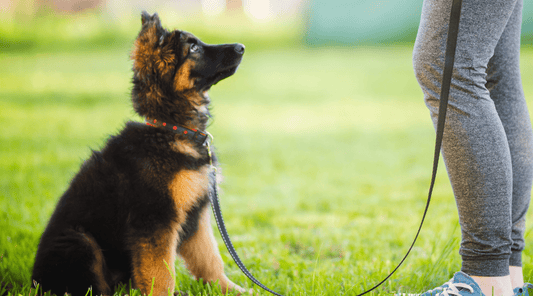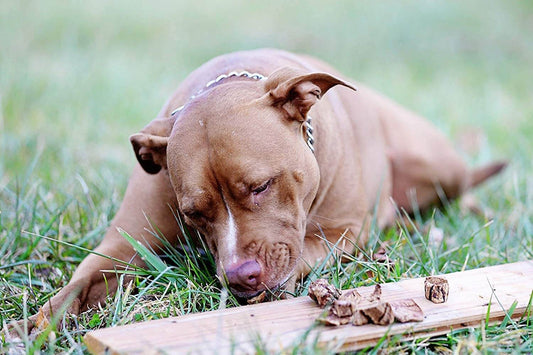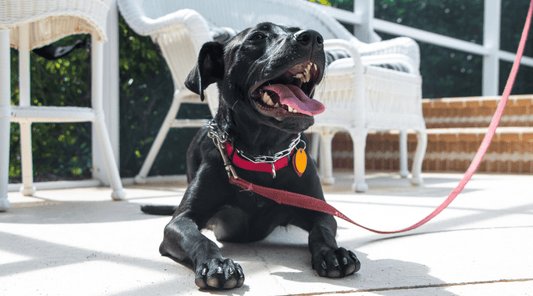
How to Address Aggressive Behavior in Dogs: Sudden Serenity
Dawn Miller Feb 03, 20255 Minute ReadSome dogs struggle with aggression. They stay on high alert, growl, and even attack. As potentially dangerous as this can be for us as pet parents, it's also miserable for the dog. They're scared, confused, and sometimes concealing unseen pain.
Last week, I ran into our neighbor, Mike, at the pet store. Between my partner and I, we had three well-behaved dogs strolling the aisles on leashes, while Mike's adolescent rottweiler mix, Duke, was notably missing.
I jokingly inquired about the invisible pup, to which Mike responded that Duke had become too much to handle. He recounted how he had to hold the leash so tight his hands hurt to keep the "teenager" from lunging at cars on the street. “I don’t know what’s gotten into him,” Mike said, exasperated. “I haven't taken him out of the yard in days. I don't know what he might do.”
This was clearly stressing Mike out. But here’s the thing: aggression in dogs is alarming, sure. Yet, it often stems from fear, confusion, or unaddressed triggers. And the good news is that most aggressive behaviors can be managed or even resolved with patience, positive reinforcement, and an aggression-informed training plan.
Spotting the Signs of Aggression in Dogs
The earlier you notice it, the better. Chances are Duke's issues have been festering and just reached their boiling point. It may take a little more time to help him feel at ease. But I'm confident we can turn this around for Mike and Duke.
So here's what to look for?
- Growling or Snarling is often a dog’s first warning signal. It means stay away or you'll "find out".
- Baring Teeth is a defensive stance that says, “Back off, or I will use these!"
- Rigid Body Language with no tail wag often indicates heightened stress or fear.
- Lunging at people, other animals, or objects happens when the dog sees the object as potential prey.
- Snapping, Biting, or Latching on is the most obvious and concerning sign. If you let it get to this point, you could get one of your neighbors, or a service worker hurt, so let's stop this aggressive behavior in its tracks.
Types of Dog Aggression
While the signs are similar, aggression has many different triggers. And looking at them can help us get to the root cause of aggression in a pup like Duke.
Here are just some key types of aggression in dogs.
Fear aggression occurs when a dog perceives something as a threat. It's common in rescues and can be resolved with rescue-sensitive training. Aggressive dog training has worked wonders for my rescue, Bruno, who suffered from debilitating fear.
Territorial aggression is a dog's attempt to protect the home and family it considers its own. It can extend beyond property lines. Dogs don't see borders.
Predatory aggression happens when a dog sees something as prey and wants to chase it. It's why they tell you never to run away from an aggressive dog. Slowly walk backward while looking down submissively. This way, they see you as a pup who accidentally wandered into their territory rather than thinking you're lunch.
Possessive aggression involves resource protection like food or bed-guarding. When you bring a new animal into the house, it's a natural reaction. Bruno showed this aggression when our new terrier, Pixie, tried to sleep on his rug.
Maternal aggression is what it sounds like—when a mother dog thinks you might hurt her pups. She's not playing!
Pain aggression is akin to wanting to lash out at the world because you are hurt and nobody understands.
Lack of socialization aggression happens when a dog hasn't been around other dogs or many people in their life. They may act aggressively toward strangers.
Now that we have a better grasp on what aggression is and why it happens, let's look at how aggressive dog training can help.
What Is Aggressive Dog Training?
Well, first of all, it's not aggressive. The word "aggressive" refers to the dog's behavior, not your training style.
Aggressive dog training is about being aware of an aggressive dog's tendencies for safety reasons and using positive reinforcement training to teach a dog how to act more constructively.
How to Train an Aggressive Dog
When Duke growled or lunged, Mike’s instinct was to yank the leash and say, “No!” But while that might stop the behavior temporarily, it doesn’t address the root cause. Positive reinforcement, on the other hand, teaches dogs what to do instead of just punishing what they shouldn’t.
I know that's easier said than done in the moment. So, let's look at how Mike can start turning this ship around.
1. Teach Basic Commands in a Low-Stress Environment
Mike began practicing basic commands in his backyard before taking it to the street.
He taught Duke to "sit", "stay", and "come" in a low-distraction environment so he could exert control over Duke without yanking and then reward him when he complied.
2. Redirect Attention
Use high-value treats to redirect your dog’s focus. For Duke, I suggested carrying some single-ingredient, natural treats to reward him when he stayed calm around cars.
Beef lung bites are Bruno's favorite.
Timing matters. We can't let Duke think Mike rewards him for chasing the car. So, Mike is learning palm treats to reward Duke when he exhibits a desirable behavior—like sitting calmly or looking at him instead of the car.
Now, if Duke starts to move toward the car, Mike would firmly say, "Duke, sit". Duke gets a treat when he sits instead of tugging.
3. Desensitize Gradually
Expose your dog to their triggers in a controlled way. For example, Mike started by walking Duke on a dead-end street and asking a friend to drive up from behind them. This allowed Mike to manage the situation in a low-stakes environment because his friend was in on it.
After this, Mike took Duke onto the neighborhood street and continued reinforcing calm behaviors with tasty treats.
To learn more about how to train aggressive dogs with videos and practical step-by-step instructions, check out this Free 7-Day Dog Training Challenge.
The Role of High-Value Treats in Training for Dogs
High-value dog treats are so tasty your dog can't resist them. They create positive associations with training and you as the pack leader. So they build trust and understanding.
Mike commented the other day that Duke seems a lot calmer in general. Consistent training and positive reinforcement are helping Duke relax and more constructively interact with the world.
High value dog treats should also enhance dog nutrition.
I buy single-ingredient dog treats and beef marrow dog bones. They have no additives or preservatives. Just vital nutrition.
I would also get dog bones for aggressive chewers. I created a list of the best dog bones for aggressive chewers here.
These are real beef bones that can stand up to heavy chewing action.
Chewing is instinct for dogs. It relieves stress, fights boredom, and entertains the dog. They makes even aggressive dogs easier to manage and train. So, a quality beef marrow dog bone should definitely be a part of any aggressive dog training.
Calm and Collected
Last bit of advice here. Give your dog the tools they need to succeed—and watch those wagging tails return.
Please speak with a professional if your dog's aggression is severe or you're worried for the safety of others.
Available On:





